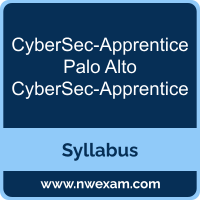 A great way to start the Palo Alto Networks Certified Cybersecurity Apprentice (CyberSec-Apprentice) preparation is to begin by properly appreciating the role that syllabus and study guide play in the Palo Alto CyberSec-Apprentice certification exam. This study guide is an instrument to get you on the same page with Palo Alto and understand the nature of the Palo Alto CyberSec-Apprentice exam.
A great way to start the Palo Alto Networks Certified Cybersecurity Apprentice (CyberSec-Apprentice) preparation is to begin by properly appreciating the role that syllabus and study guide play in the Palo Alto CyberSec-Apprentice certification exam. This study guide is an instrument to get you on the same page with Palo Alto and understand the nature of the Palo Alto CyberSec-Apprentice exam.
Our team of experts has composed this Palo Alto CyberSec-Apprentice exam preparation guide to provide the overview about Palo Alto Cybersecurity Apprentice exam, study material, sample questions, practice exam and ways to interpret the exam objectives to help you assess your readiness for the Palo Alto CyberSec-Apprentice exam by identifying prerequisite areas of knowledge. We recommend you to refer the simulation questions and practice test listed in this guide to determine what type of questions will be asked and the level of difficulty that could be tested in the Palo Alto CyberSec-Apprentice certification exam.
Palo Alto CyberSec-Apprentice Exam Overview:
| Exam Name | Palo Alto Cybersecurity Apprentice |
| Exam Number | CyberSec-Apprentice |
| Exam Price | $150 USD |
| Duration | 90 minutes |
| Number of Questions | 50 |
| Passing Score | 860 on a scale of 300 to 1000 |
| Exam Registration | PEARSON VUE |
| Sample Questions | Palo Alto CyberSec-Apprentice Sample Questions |
| Practice Exam | Palo Alto Networks Certified Cybersecurity Apprentice Practice Test |
Palo Alto CyberSec-Apprentice Exam Topics:
| Section | Weight | Objectives |
|---|---|---|
| Cybersecurity | 20% |
- Identify and describe vulnerabilities and exploits - Identify and describe the stages of the cyber attack lifecycle
- Identify and describe common attack types (e.g., malware, insider threat, C2, social engineering, AI-powered)
- Identify and describe threat prevention systems and practices (e.g., end user awareness, security updates, antivirus, intrusion prevention systems, firewalls) |
| Network Fundamentals | 14% |
- Identify and describe types of area networks
- Explain external (north-south) and internal (east-west) traffic flow patterns for environments |
| Network Security | 19% |
- Identify and describe network segmentation methods (e.g., IP subnetting, VLAN)
- Explain the function of stateful firewalls and next-generation firewalls (NGFWs)
- Explain the function of data loss prevention (DLP) |
| Endpoint Security | 13% |
- Identify and describe internet of things (IoT) devices and endpoints - Explain the objectives of endpoint security and network security - Identify and describe endpoint security components
- Differentiate between single-factor authentication and multi-factor authentication |
| Cloud Security | 16% |
- Identify and describe the four cloud-computing deployment models - Identify and describe common cloud service models
- Explain the cloud shared responsibility model |
| Security Operations | 18% |
- Explain security operations functions
- Identify methods to optimize security operations center (SOC) performance (e.g., automation and AI, collaboration and information sharing, regular Security policy updates, security framework alignment) |
Palo Alto CyberSec-Apprentice Exam Description:
The Palo Alto Networks Certified Cybersecurity Apprentice exam is for individuals entering or transitioning to a career in cybersecurity. The exam is designed to provide those seeking an entry-level cybersecurity position or those with non-technical roles (e.g., marketing, sales, program management, general, administrative) the opportunity to demonstrate their networking and cybersecurity knowledge. It will validate a candidate’s foundational-level knowledge and understanding in the areas of cybersecurity concepts, network fundamentals, endpoint security, security operations, network security, and cloud security.
